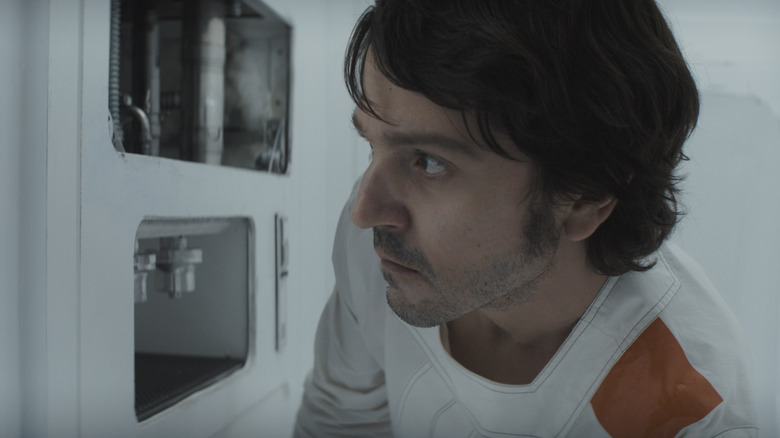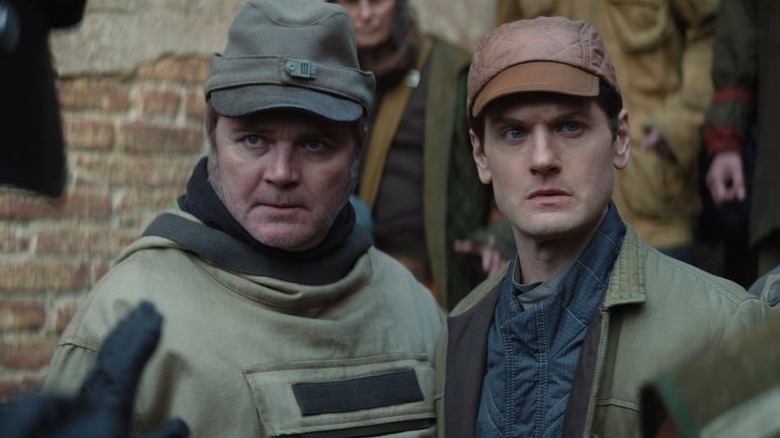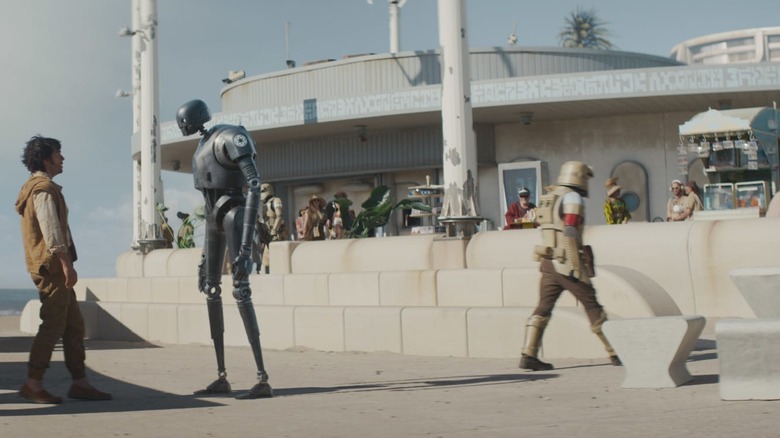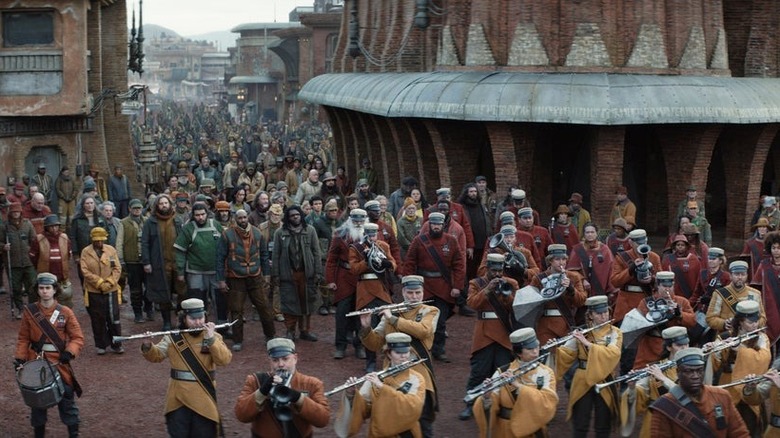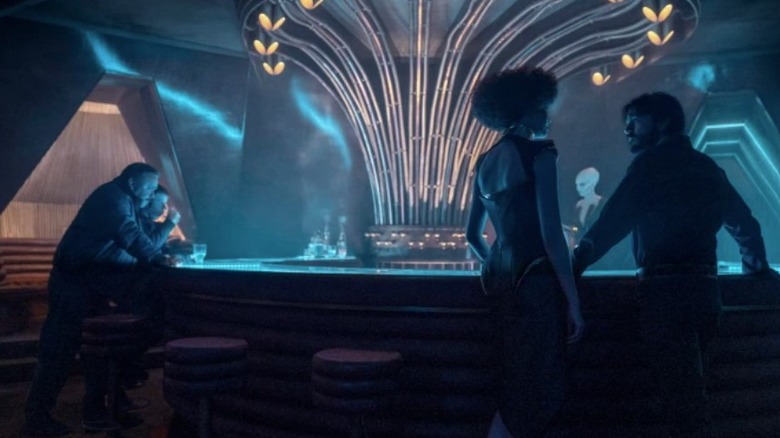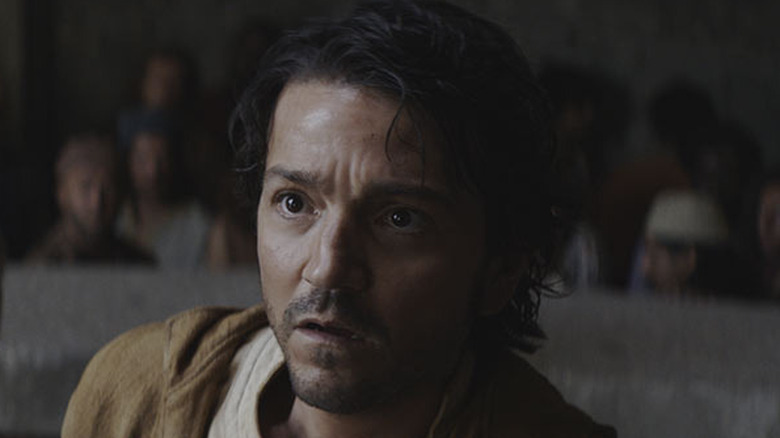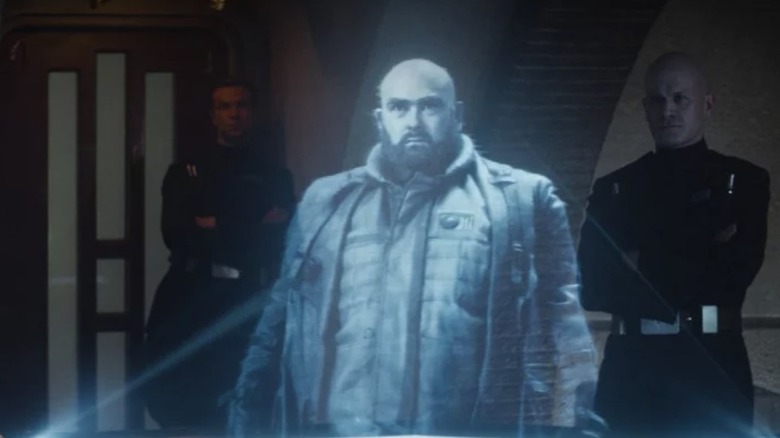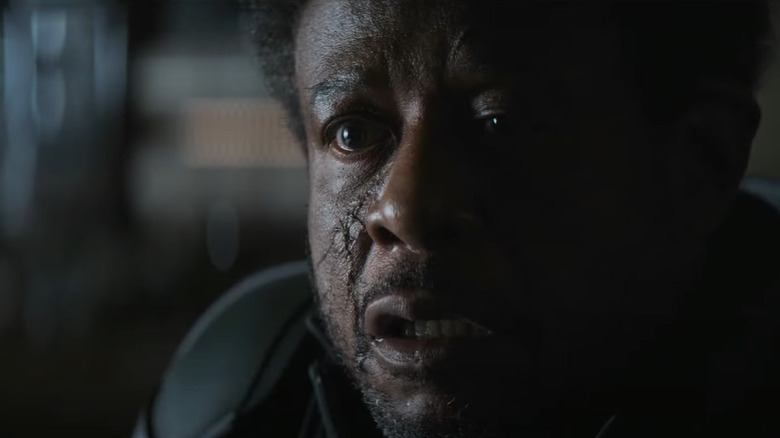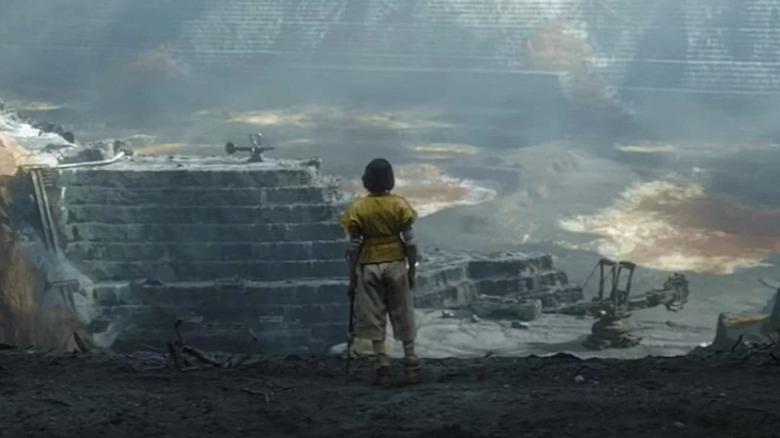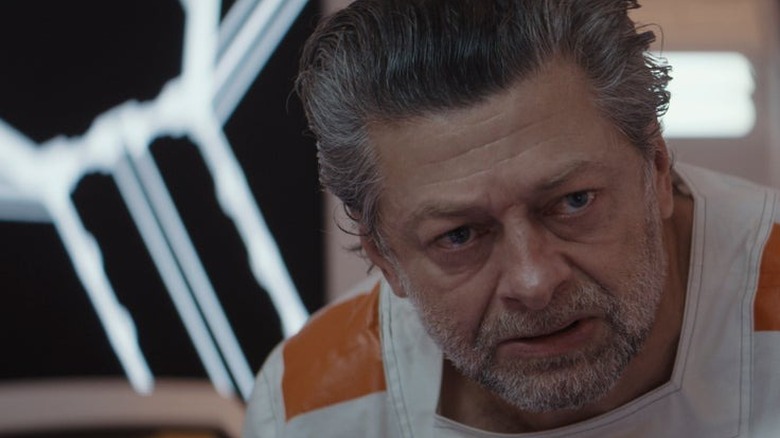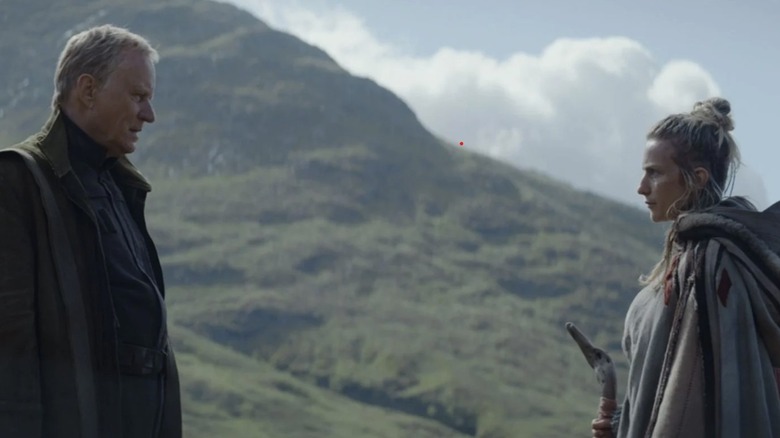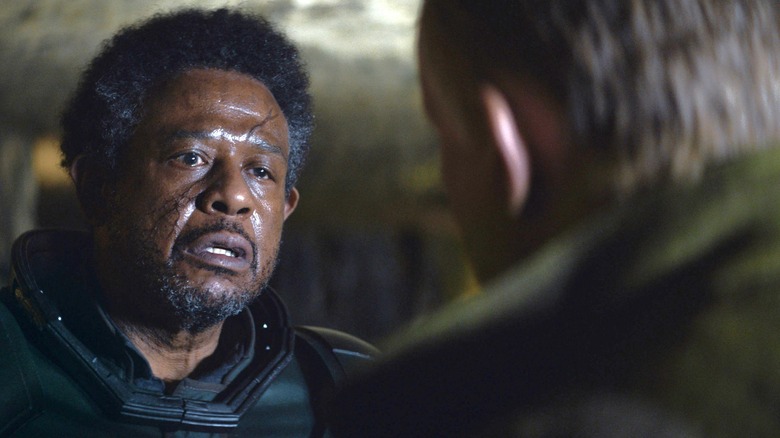Moments In Andor Season 1 That Make No Sense
"Andor" brought a head-spinning number of firsts to the "Star Wars" galaxy. These included the first mouse droid sidestep, the first arranged marriage, and the first breakfast cereal. Welcome as these obvious moments were, the series also brought in some head-scratchers.
One of "Andor's" best qualities is its predilection to show, not tell. Its weakest moments come when characters are speechifying or spelling out the obvious. When viewers are trusted to figure out the action and connections for themselves, they feel far more involved and attuned to these new aspects of the galaxy.
Stiil, the showing sometimes goes too far, or the rapid-fire, naturalistic dialogue is a little too naturalistic. Some of the quick pivots slip past even the most avid "Star Wars" fans (Who cheered the canon introduction of Emperor's Hands in the form of a character's tattoo?). While "Andor" handles its subtle fan service beautifully, a few moments could still use some clarification. We'll do our best here.
The hats
In "Andor's" Season 1 finale, Syril Karn rejoins his former Pre-Mor sergeant. Linus Mosk still refers to the disgraced Karn as "sir," likely because he continues to honor the motivations behind his actions on Ferrix. The two return as civilians, and just before they land, Mosk holds out his hat to Karn, who silently exchanges it for his own. Nothing was said regarding this, and Mosk ends the bloody day without any hat at all.
The most obvious explanation is that Mosk's hat was orange and very much like the one Karn wore while still serving as a deputy inspector. Thus, Mosk was quietly reaffirming his continued deference to Karn, or Mosk sensed that Karn, who was somewhat irritably playing with his cap, would prefer his own, and he was simply performing a bestie service.
The switch is potentially tactical, too. It was performed without Mosk ever looking in Karn's direction. They could have been attempting to confuse anyone who was monitoring their movements. After all, they were there on their own, under no one's orders, in an attempt to take down Cassian. The always-perceptive Generation Tech made the interesting and highly plausible argument that the men were changing covers so that they could more easily find one another in potential chaos.
In any case, we're always fascinated by and ready for the fashion moves of Syril Karn. He's the new and better Padme Amidala, an icon whose mood is ever discernable via tailoring. Don't ever discount his accessories.
Red Bull in space
In Episode 7, Cassian's extremely temporary friend, Windy, asks him to visit Space Walgreens for "Peezos" but not just any Peezos, the "greenie green" ones. She adamantly goes into detail about this, mentioning that a nearby store has them newly in stock. It was a bizarre piece of dialogue, the first of its kind in for "Star Wars," since characters are always too busy twirling lightsabers or saving the galaxy for a snack run. What are Peezos? Was this the introduction of intergalactic Cheez-Its?
Popular opinion tilted to agreeing that these are cheerful goodies likely to pop up in Disney Marketplace just in time for the holidays, but no, this is "Andor," and Peezos are a form of speed.
Then StarWars.com stepped into the confusion and posted the explanation that Peezos are "a form of legal pep pill or stimulant popular on both bustling Coruscant and laid back Niamos." Cassion is continuing to self-medicate out of his pain and lack of direction.
Given this context, Peezos seems more nefarious than truck stop caffeine pills or energy drinks, given that this crowd tracked the supply chain like Jay and Silent Bob waiting for their supplier to bag up the new delivery of Grandaddy Purple. Cassian dutifully heads outside to make the purchase, merely to wind up, as only Cassian can — sentenced to six years in an Imperial labor camp. "Saved By the Bell" was right: Caffeine pills can't speed away your problems.
Theme, please?
It's difficult to discern exactly what the opening theme song of "Andor" is just from watching the show because it changed each week to reflect the developing storyline. This was most discernable in the Season 1 finale when the threads from previous episodes were laden with the dissonant chords of the marching bands of Ferrix.
These weren't the smooth, well-practiced chops of a professional marching band. Although the band's outfits seemed slightly bedraggled and homemade, they were military-style, worn with pride, and carefully straightened before Maarva's funeral. Most noticeably, its notes are jarringly dissonant. The melody doesn't swing like something out of "The Music Man."
In the climax of the episode, the band and the citizens converge from two streets. The Time Grappler at the anvil — the real hero of this series — serves as a high-placed drum major of sorts, symbolizing the industrial roots of the city and taking out a stormtrooper while he's at it (Re-watch "Andor's" trailer. Those initial images of the anvil truly forecast the series, even though it's easy to assume the anvil was left behind when Cassian departed Ferrix).
Like the rising Rebellion, this music isn't unified or pretty. It does its job, and by the time the Rebellion develops into something more appropriate to some John Williams thundering, we'll be ready for it. That's what a reckoning sounds like.
The new Star Wars Brothel Playset from Kenner
"Andor" caused a stir with its surprisingly raw language and the location of its opening scene, which is situated in a brothel. The setting doesn't involve any explicit visuals, but these are not the sorts of details audiences tend to associate with "Star Wars," the PG ceiling of which has been mild swearing and a severed arm or two on the floor. Cassian is in the brothel to find his sister, whom he never located, and the setting is never shown or mentioned again. The scene propels Cassian into a fight with some security officers who follow him out the door, but this could have taken place in any workplace — a grocery store, a dentist's office, a cantina (where would we be without "Star Wars" cantinas?). So why take the unnecessary trip into a red-light district?
For perhaps the same reason showrunner Tony Gilroy included a same-sex couple, two morning-after scenes between unmarried pairs, and the R-rated words. He's testing censorship boundaries at Disney. "I wrote (the brothel scene) as a challenge," he told "Variety," and the same-sex couple depiction was "a gesture." Production of "Andor's" second season is already underway, so it remains to be seen how far "Star Wars" material will slip down the slope Gilroy has built. In any case, it's probably a good idea for parents to keep the five-year-old off the couch until they've had a chance to pre-screen future intergalactic adventures.
Names mismatch
One of the difficulties of theming a new "Star Wars" property is that the original trilogy was released from 1977 through 1983, which means its fashion and technology, though set "a long time ago in a galaxy far, far away," reflects a certain amount of grooviness. Showrunners in the 21st century must now continue to match the aesthetic of "futuristic" films made before the iPhone was even thought of.
In Episode 7, Cassian is sentenced to six years in prison for ... walking rapidly. Viewers of a certain age were delighted by the appearance of a prop that looked like it started life as an old-school ka-chunk, ka-chunk credit card machine. In "Andor," however, it has a far more sinister purpose than facilitating the purchase of Cyndi Lauper's latest cassette. This is a machine the Empire uses to process criminal records.
These records are printed in Aurebesh, the distinctive universal language of the "Star Wars" galaxy. Fans like Avela Vendela had an Aurebesh alphabet chart and a YouTube channel at the ready and translated away. Two data plaques were shown, and neither matched the prisoners under discussion. Maybe they were just excuses for the prop masters to shout out their buddies (one "prisoner," Keith Seymour, is a concept artist for "Andor"). From an artistic point of view, however, the rapid shuffling serves as a commentary on how quickly and cavalierly the Empire is tossing human beings into lifelong servitude.
What was the deal with Anto Kreegyr?
It's okay to be confused about Kreegyr. Nobody knew what the deal was with Kreegyr, including Kreegyr, who was slaughtered with the rest of his men when walking into an ISB trap.
The narrative purpose of "Andor" is to illustrate the tremendous sacrifices, long odds, loneliness, and disorganization of the early Rebellion, when difficult decisions were made by grey heroes like Luthen Rael, who, as an accelerationist, takes on the tactics of his enemy to defeat them. This means that like Palpatine, he often decides who lives and dies in the service of a broader goal.
Kreegyr and his cell were one such sacrifice. He was planning on taking anti-Imperial action at a power station on a planet called Spellhaus. Rael wanted Saw Gerrera to at least consider meeting up with Kreegyr to hear his pitch to provide air support. Saw declined because he was a Partisan and Kreegyr a Separatist — two factions with a common Imperial enemy who nevertheless refused to team up. It was almost as if they needed to form ... an alliance.
Rael, knowing of the plot could fail because of Saw's rebuff, allows the Empire its ambush, well aware that it would protect Lonnie while providing the ISB with a win that would increase its arrogance and narrow its vision, just as Cassian mentioned when Luthen recruited him. Indeed, the Imperial victory lowers the Empire's guard just in time for the Ferrix uprising.
Saw's Gerrera's location
Okay, so where is Saw Gerrera when he appears in "Andor"?
Saw is a man of many locations. His 20 might not be consistent, but his presence is always welcome. In "Andor," Saw's presence is filtered through the activities of early Rebel leader Luthen Rael. Where series order is concerned, Saw already appeared in "Star Wars: The Clone Wars," "Rebels," and "The Bad Batch," first as a recently radicalized youth and then as a renegade resistance leader. In "Andor," he's replete with cash, followers, and a fairly healthy weapons cache.
Hunkered down in a cave, his guerilla tactics against the Empire have already forced him to go on the run, even in these nascent stages of the Rebellion. At this point in the pre-Battle of Yavin timeline, Saw is on Segra Milo. It's a planet, and it has caves, and that's pretty much all we know about it. However, it's likely on the edges of the Empire's reach, perhaps near the Outer Rim.
What fuels that guess? In Episode 11, "Daughters of Ferrix," Luthen is returning from a visit with Saw on Segra Milo when he's hailed by a Cantwell-class Arrestor. In a "piracy zone," his traffic violation looks suspicious, and shady piracy zones tend to crop up anywhere but the space equivalent of Grand Central Station.
Every single thing happening on Kenari
The most confusing events of "Andor" take place at the beginning of the series in the wilds of Kenari, where Cassian Andor spent his early childhood. A group of children — no adults to be seen — watch an (apparent) Republic spacecraft go down and prepared themselves to examine it.
Although the crew members wear Separatist logos, the ship is meant to "look" like a Republic craft. Maarva and Clem, who come to scavenge for parts, beat it as soon as Bee announces that a Republic ship is on the way. Maarva takes young Cassian with them, pointing out that "his people" had just "killed a Republic officer" and that all were safer this way.
Was it an intentional retcon? Was it a Republic ship taken over by Separatists? Cassian said in "Rogue One" he was "in this fight" since he was six and that he "lost everything"— was this moment the actual start?
The issue is so blatant that most viewers expected an explanation by the season's end, but it remained a mystery. The string of scenes on Kenari was confusing, which seems purposeful, given that no translation was provided for the language the children were speaking. What was the environmental disaster or strip mining event that young Cassian saw? Did anyone else on Kenari survive, especially Cassian's sister despite Maarva's assurance that he was the lone survivor?
Kino's voice sounds familiar...
Andy Serkis' practically perfect turn as an Empire-aligned prisoner raised some eyebrows in the fandom. Serkis also provided the voice and motion capture for Snoke in the sequel films. A standing criticism of the sequels centers on their serial failure to develop most of the characters. And Sith baddie Snoke was one of these. He appeared, he sat on a throne, and he was run through with a lightsaber. Given Disney's subsequent avoidance of the sequel era, speculation swirled that Loy, masterfully drawn over just three episodes, would eventually become Snoke.
Theories accelerated after Cassian and his fellow prisoners escaped, unwittingly leaving Loy behind. "I can't swim," Loy shouts just before his former charge is accidentally pushed into the sea. His marked lack of panic and calm smile seem to indicate his agreement with Cassian's exclamation that "whatever happens now, we made it." Loy's death is not shown, merely implied. Does that mean the Empire captured him and he fell into the hands of Emperor Palpatine as a cloning experiment? Was this a post-sequel way of retconning some detail into a character that most fans seem to want to forget?
No, thankfully. The powers that be heard the roar of speculation and want everyone to stop that right now. StarWars.com employed an interview with Serkis to quash them.
Kino Loy deserves so much more than an afterlife in the sequels, even if that means he never made it off Narkina 5.
Luthen and Vel's weird snappy relationship
When Luthen brings Cassian to Vel's cell on Aldanhi, she wants none of the new guy. As Luthen details the change in plans, Vel pouts, sullenly slamming her shepherdess stick into the ground. Luthen puts up with none of this, and snarls, "Look at me!" She does. He is in charge.
After the heist, Luthen avoids seeing Vel until the finale on Ferrix. He wants her to lie low and fend for herself, although she constantly seeks him out. Their interactions are at once too formal and too fraught to reflect a romantic relationship, and there are no other hints that Luthen is her father or some other relative.
Vel likely battles father issues, given Cinta's reveal that she'd run away from her wealthy home, possibly for the sole purpose of joining the Rebellion. She couldn't have cast off her entire family, however, since her interactions with her cousins, Mon Mothma and Leida, reveal a genuine warmth beyond that which usually arises between two compatriots.
Vel seems desperate for affirmation and affection, but she doesn't receive it from arms-length Luthen. However, he trusts her because she was granted leadership of the crucial and audacious Aldanhi action. He knows her well, too, predicting her reaction to Cassian down to the facial expression. Luthen was likely prepping Val for further leadership, perhaps to even to succeed him. For that to take place, there's little room for coddling.
Saw Gerrera namedrops pretty much the whole galaxy
Meant to evoke World War II dynamics, the original use of the term "Rebel Alliance" was heavy on the first half of the phrase with scant development of the second. "Rebels" showed the early Rebellion was fragmented. While the Separatists seem to present a common front against the Republic in the Clone Wars, it was composed of many groups. However, they work together despite themselves because Palpatine is secretly orchestrating both sides of the war.
Luthen Rael is willing to burn smaller cells to protect high-value assets, but his goal isn't a self-serving war of attrition that drags on for years. He seeks the permanent downfall of one enormous enemy. Saw's roll call of anti-Imperial groups, each with separate agendas, demonstrates the chaos Rael is attempting to organize. Some were already canon, but the interests of others were suggested by the titles:
Partisans: Armed "homegrown" groups using terrorist tactics
Neo-Republicans: Those attempting to transform the Empire back into the Republic
Ghorman Front: Protestors at the Ghorman Massacre, which drove Mon Monthma out of the Senate
Sectorists: Perhaps those dedicated to the Empire-divided sectors spoken of in ISB meetings
Human Cultists: Anti-non-human movement
Partitionists: Secessionists seeking a break-up of the galaxy
The thick webbing of all 12 episodes of "Andor," each moving through a wide variety of places and characters, makes it difficult to keep track of them all — which is probably why Luthen looks like he could use some sleep.
